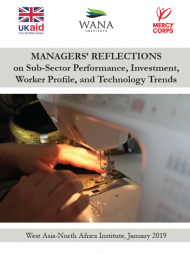-
Managers’ Reflections on Sub-Sector Performance, ...
Managers’ Reflections on Sub-Sector Performance, Investment, Worker Profile, and Technology Trends
The signing of the Jordan Compact in February 2016 unleashed a wave of optimism that a larger workforce combined with improved trade access for industrial goods would ignite a surge in growth of Jordan’s manufacturing sector. Between 2010 and 2016, GDP from manufacturing in Jordan grew by 13 per cent, and manufacturing employment grew by 19 per cent. While these figures are notable, the overall performance of this sector has been below expectations. Much needed investment flows have not been forthcoming, and many questions around automation, mechanisation, and worker redundancy remain unanswered.
In an effort to understand the outlook, trends, and overriding characteristics of Jordan’s manufacturing sector, the WANA Institute conducted a series of interviews with firm managers across ten industrial sub-sectors, including cosmetics and chemicals, cotton and textiles, engineering and IT, food processing, packaging, paper and cardboard, plastic and rubber, renewable energy, pharmaceutical and medical, water, and wood and furniture. Discussions taking place over the course of 30 interviews explored questions on the performance of the sub-sector, recent and future investments in fixed assets, human capital investment and training, notable skills gaps, and future technology trends. While this report draws tentative conclusions on skills gaps, investment preferences and other trends, it should be noted that the overall methodology was qualitative in nature. The interviews provide reflections, rather than concrete figures, on trends shaping the business environment in ten different industrial sub-sectors.

